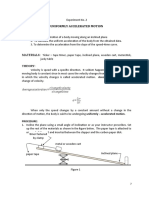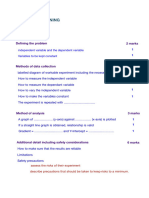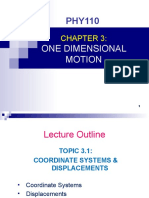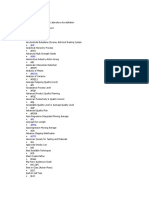EXPERIMENT 4
ONE DIMENSIONAL MOTION
INTRODUCTION
This experiment explores the meaning of displacement; velocity, acceleration and the
relationship that exist between them. An understanding of these concepts is essential to a later
study of more complex motion and the relationship between force and motion. The experiment
allows you to record graphically the changes in displacement, velocity and acceleration that occur
when constant forces are applied to objects, using the computer as a data acquisition and analysis
tool.
THEORETICAL BACKGROUND
Displacement (distance), velocity (speed) and acceleration are three necessary concepts to
be understood before one can undertake a study of the physics of motion called “kinematics”. To
describe the motion of an object we must be able to define the direction in which the motion is
occurring, the speed with which the motion occurs; and details regarding how the speed of the object
changes as the motion takes place. You will have learned from your class-work that this information
is contained in three vector quantities of displacement, velocity and acceleration.
In this experiment we will be dealing only with motion in a straight line (i.e. in one dimension).
In one dimensional movement if the distance travelled by an object is x and the time taken is t,
then the average speed of the object is simply:
s
average speed ,v
t
The limiting value of the average velocity as the time interval t approaches zero gives the
instantaneous velocity,
s ds
v lim v lim
t 0 t 0 t dt
One can define the average acceleration and instantaneous acceleration in a similar way to
that already discussed. Thus we have:
v
average accelerati on ,a
t
and
2
v dv d s
a lim a lim
t 0 t 0 t dt dt
For the special case of constant acceleration a set of equations can be derived which relate
the displacements and velocities at various times to the acceleration. The derivation of these
equations is given in your textbook as,
vv 0 at
(v v 0 )t
x x 0
2
v 0 t at 2
x x 0
2
2
v 2 v 2a (x x 0 )
0
25
�In these equations, v0 is the original speed of the object at time, t = 0; v is the speed of the object at
time t; (x -x0) is the distance travelled in time t and a is the (constant) acceleration during this period.
Finally, we note that three quantities x, v, a can be displayed graphically as functions of time.
The figures shown below give the displacement as a function of time for two different objects. The
first (object A; Figure 1) is travelling at a constant velocity such that its displacement-versus-time
graph is a straight line. The slope of the displacement-versus-time graph at any time gives the
velocity at that time. Since the graph is a straight line, the velocity must be constant and thus the
instantaneous velocity must always equal the average velocity. In these circumstances, the
acceleration is zero since the velocity does not change.
In figure 1 we have an example of an object undergoing with constant acceleration. The
displacement versus time graph is an upward curve. This means that the object is travelling further
in equal time intervals as the motion progress -i.e. its velocity is increasing. Here the instantaneous
velocity does not equal the average velocity. The instantaneous velocity is given by the value of
dx/dt -i.e. by the slope of the tangent to the line at any point. Clearly this slope increases as time
increases - in other works the object is accelerating. To obtain the acceleration we would have to
construct a velocity-versus-time curve, extracted from the curve bellow, by calculating the slope of
the tangent at every point. This is done in Figure 1(uniform motion) where it can be seen that the
velocity-versus-time graph is a straight line.
Figure 1: Position, velocity, and acceleration as functions of time.
THE EXPERIMENT:
This experiment uses a variety of options for collecting information for the physical
phenomena described above.
1- Experimental Apparatus:
26
� The apparatus consists of a microcomputer connected to Lab Pro Lab Interface box, an
Ultrasonic Motion Detector, a Logger program for Windows, a clamp, rods, a pulley, a wooden block,
a metal cart, and weights.
Figure 2: Motion detector and Logger pro software interface
2- Experimental Procedure:
Clamp the pulley to the edge of the table using the clamps provided.
Fasten one end of the provided string to the metal cart and put a nut to hold the mass hanger on
the other end of the string.
Set the provided masses on the metal cart.
Plug the Ultrasonic Motion Detector into DIG/SONIC 1 of the LabPro interface.
Place this motion detector on the same side as the pulley at about 50-cm distance from the metal
cart.
Make sure that the image of the cart is seen on the golden coloured plate of the motion detector.
Pass the mass hanger over the pulley and make sure that the stretched string is parallel to the
table.
Switch on the computer, and monitor.
Open Logger Pro using the icon on the desktop.
From the Menu Bar, choose the File menu to open the MOTION file in Physics_Experiments
folder
Click on the Collect button of the toolbar in order to start the action of the Motion Detector (MD).
While operating the motion detector emits short bursts of 40 kHz ultrasonic sound waves from
the gold foil of the transducer. These waves fill a cone-shaped area about 15 to 20° of the axis
of the centerline of beam. The MD then “listens” for the echo of these ultrasonic waves returning
to it. By timing how long it takes for the ultrasonic waves to make the trip from the MD to an
object and back; distance is determined. The MD will report the distance to the closest object
that produces a sufficiently strong echo. Objects such as chairs and tables in the cone of
ultrasound can be picked-up the MD.
Select the Data menu from the Menu Bar, then Delete data set.
Select an experiment length of 5 seconds, using the Timing button in the toolbar or by choosing
the Timing option from the Experiment menu.
Have the metal cart with its added weight at about 50-cm distance from the MD, then let the
weight hanger slide over the pulley as soon as you click on the Start button of the toolbar.
When the collection of data is finished (the collect button turns green and the MD stops its clicking
sound), and once your are satisfied with the collected data, save the data file in D or USB Drive:
under the name: met_cart.exp.xmbl
27
� Motion
Detector
Pulley
Cart
Weights and
Table mass hanger
Figure 3: Experimental set-up for the moving cart
ANALYSIS OF RESULTS:
On the LoggerPro Program Menu Bar, the Analysis menu provides access to various options
for data review and analysis. You can turn on an examination cursor and tangent lines. You can
zoom in and out on the data, auto-scale the graph, or try to fit a function to the data. If you select a
region of a graph (this is accomplished by pressing on the left mouse key and dragging the mouse
over the desired region then releasing the left mouse key) you can get the statistics, the regression
line, the integral, or try a curve fit on just that region.
Open the experiment file met_cart.xmbl and select a regular region of the distance-versus-time
curve.
To this region try to fit a Quadratic function by choosing the Automatic Curve Fit from the
Analysis menu. Once the fit is finished keep it.
Select the corresponding region of the velocity-versus-time curve and try to fit a Linear
mathematical function to the data by choosing Automatic Curve Fit from the Analysis menu.
Once the fit is finished; keep it and report the values of M and B to Table 2 of your laboratory
report.
For the acceleration-versus-time curve, select the same region and choose Statistics for the
analysis menu in order to determine the average acceleration of the metal cart and report the
value in the data table, and then get a print out of your computer graphs corresponding to
met_cart.xmbl.
4. DATA ANALYSIS
From your computer-generated graphs calculate the followings:
a- Average velocity from the initial time (ti) to the final time (tf). Show your work.
b- Average acceleration from initial time to the final time. Show your work.
Since the slope of a velocity-versus-time graph is acceleration, the value of M for this graph
should be close to the value of the average acceleration from the statistics of the acceleration
vrs. Time graph. Examine the appropriate quantities in Table 2 and calculate percent differences.
5. CONCLUSIONS
What conclusions regarding the relationships between displacement; velocity and
acceleration have you arrived at as a result of this experiment? In particular, do your data agree
with the predicted relationships for acceleration given in equations (1) - (4)?
28
� PHY 1401 LABORATORY REPORT
EXPERIMENT 4
ONE DIMENSIONAL MOTION
NAME: _____________________________ DATE: ______________________________
SECTION: __________________________
THIS PAGE NEEDS TO BE DONE AT HOME BEFORE COMING TO THE LAB. SESSION
1. EXPERIMENTAL PURPOSE:
State the purpose of the experiment.( 5 points )
2. EXPERIMENTAL PROCEDURES AND APPARATUS: (5 points)
Briefly outline the apparatus
General procedures adopted.
29
�3. RESULTS AND ANALYSIS
Do a sketch of the graphs obtained in your computer (30 points)
Summary of computer generated graphs. (15 points)
Table 2: (10 points)
Graph M B AVERAGE
Velocity
Acceleration
4. DATA ANALYSIS (15 points)
30
�5. CONCLUSIONS (10 points)
31
















































































